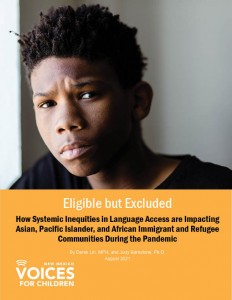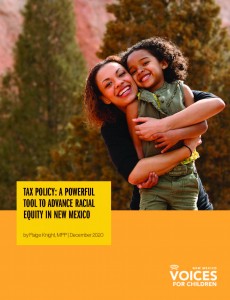Racial & Ethnic Equity
Because we understand that racial disparities – which are often the unintended result of public policies and structures – overlay all of our issue areas, we consciously undertake efforts that neutralize racially inequitable impacts. Although race is a social construct with no scientific basis, personal biases and discriminatory practices have led to disparities along racial and ethnic lines. Just as wealthy families hand down their advantages to future generations, racial/ethnic disparities have impeded generation upon generation, and continue to do so.
Featured Content
 Guaranteed Income: Increasing Employment and Helping Families Thrive
Guaranteed Income: Increasing Employment and Helping Families Thrive
Research shows that when people are given unrestricted cash payments — sometimes called guaranteed income (GI) — they pursue better jobs, complete educational or vocational training, and create stability for their families. This report (available in English and Spanish) looks at how a GI pilot program for immigrant families in New Mexico improved outcomes for participating families.
 Eligible but Excluded: How Systemic Inequities in Language Access are Impacting Asian, Pacific Islander, and African Immigrant and Refugee Communities During the Pandemic
Eligible but Excluded: How Systemic Inequities in Language Access are Impacting Asian, Pacific Islander, and African Immigrant and Refugee Communities During the Pandemic
A follow-up to our Essential but Excluded report, this looks at how Asian/Pacific Islander and African immigrants and refugees are unable to access public benefits for which they are eligible – and not just during the pandemic – due to a pervasive lack of language access at many state agencies. This, despite federal laws requiring such access.

Tax Policy: A Powerful Tool to Advance Racial Equity in New Mexico
Systemic racism isn’t accidental – it’s the result of public policies that benefit one group while disadvantaging others. Our state and national tax systems have been built to benefit those at the top (who are mostly white) while disadvantaging people of color. This report looks at concrete ways New Mexico can make our tax system more equitable.
Recent Publications
Support the State Climate Health Program (HB 108) and Extreme Weather Resilience Fund (HB 109)
Fact Sheet Climate change puts New Mexicans’ health and well-being at risk. We must take action to help our communities adapt and build a healthy future. (State-level data on problems related to climate change.)
2024 New Mexico KIDS COUNT Data Book
NM KIDS COUNT Data Book Child well-being continues improving in New Mexico, thanks to investments by our lawmakers. This annual report provides data on numerous child well-being indicators related to economic security, education, health, and family and community, and includes policy solutions. (State-, county-, tribal- and school district-level data on child well-being.)
Recent Blog Posts
The Big Beautiful Bill Passed – What We Need From You
Dear Friends, On July 4th, the President signed a [...]
Federal SNAP Changes Will Mean More Hungry New Mexicans
No one deserves to go hungry, and the vast majority of our friends and neighbors in New Mexico have held this fundamental belief for generations. But despite the proven success of the Supplemental Nutrition Assistance Program (SNAP), Congress is seeking cruel cuts to federal funding that will leave many families hungry.
Recent News Coverage
Advocacy group talks report ranking New Mexico last for child wellbeing
KOB--The 2025 National Kids Count is in, putting New Mexico at the bottom for child well-being. “A reminder that these numbers are from 2023, so we hadn’t fully implemented our almost universally free childcare and access to pre-K yet in 2023, it was just starting to roll out. That number we expect it to rise in coming years,” she said. Graduation rates are still trending upward, but stats that do raise some eyebrows are math and reading scores.
Report: NM’s child well-being shows mixed momentum
Public News Service--A traditional marker used to measure child well-being in the U.S. shows New Mexico notched both improvements and declines in several areas. The Annie E. Casey Foundation's Kids Count Data Book historically shows New Mexico at or near the bottom of its report, which puts it at 50th in the nation. Emily Wildau, senior research and policy analyst at New Mexico Voices for Children, said it is important to remember the data was collected in 2023, when kids and families were experiencing severe inflation from the pandemic.
Programs, Coalitions & Networks
Transform Education NM Formed in response to the hallmark Yazzie/Martinez v State of New Mexico lawsuit, TENM works to center student equity in our K-12 system and to ensure that our communities are leading the way to fundamentally reimagining and transforming our schools. Its platform advocates for a public education system that: embraces and incorporates the cultural and linguistic heritage of our diverse communities as a foundation for all learning; provides extended learning opportunities; values our teachers and educators; allows all children to access early learning programs; offers services such as counseling and health clinics to promote learning; and ensures our schools receive the financial resources required to meet the needs of all children.
Economic Relief Working Group A coalition of several grassroots and advocacy organizations – many of them focused on immigrant rights – ERWG was formed in 2020 initially to secure pandemic relief for those New Mexicans who did not qualify for federal relief due to their immigration status. ERWG worked on getting an accurate 2020 Census count for the state, and has also worked on wages, voting rights, tax credits and child care assistance, and currently runs a guarantied basic income (GBI) pilot project for families with mixed immigration status.
New Mexico Civic Engagement Table A project of the Center for Civic Policy, NMCET unifys more than 40 diverse organizations from different sectors around a common agenda to strengthen our democracy. Among its issues are economic justice, early childhood education, climate justice, immigration reform, and economic development.
Resources
We led an initiative called Race Matters in 2006 with funding from the Annie E. Casey Foundation. The materials they developed for this work are still available on their website.
